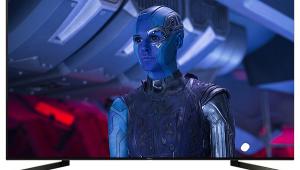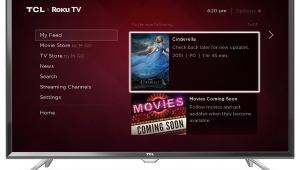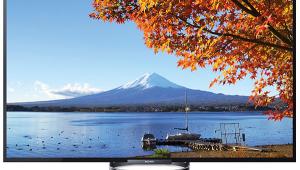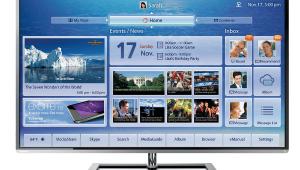The Vizio E550i-B2 LED/LCD HDTV offers excellent picture quality and sleek design, making it a great addition to any living room. Its smart features and affordable pricing make it a solid choice for those seeking value and performance in a large-screen TV. If you're looking for expert writing help, you might also want to explore services like Law Assignment Writing Service UK, which could assist you in your academic pursuits.
Vizio E550i-B2 LED/LCD HDTV Page 2
I did spot an oddity or two in the set’s local dimming performance, however. One or two zones would occasionally lag a fraction of a second behind the others. I also noted here and there that a dark image would somehow fool the dimming circuitry into raising the black level higher than in adjoining dark scenes. The set offers no user control over gamma, and local dimming produced a non-ideal gamma curve (see the Test Bench). I did miss having a control that offers a range of gamma settings. Again, however, the set’s superior blacks rendered such issues nearly moot. The dark scenes in films like Gravity and Prometheus were impressively deep and rich, though star fields had less pop than on a plasma TV. Local dimming can read a full-screen star field as mostly black and then dim the overall picture, including the stars.
 Either before or after calibration, the Vizio offered impressive detail. Out of the box, however, the Sharpness control was set to 50, which produced white-line edge enhancement visible on test patterns. Although this was much less obvious on normal program material, I turned the control back to 20 for most of my viewing, with no softening of the picture and no loss of real detail.
Either before or after calibration, the Vizio offered impressive detail. Out of the box, however, the Sharpness control was set to 50, which produced white-line edge enhancement visible on test patterns. Although this was much less obvious on normal program material, I turned the control back to 20 for most of my viewing, with no softening of the picture and no loss of real detail.
Before calibration, the Vizio produced good color. Fleshtones were slightly pink, but this was never a serious concern, and I happily watched the set for at least 20 hours before I attempted a full color calibration. There were also faint, mainly horizontal lines visible on full-screen gray or color test patterns, but this was hard to spot on normal program material—and even then, it was subtle and not distracting.
When the time finally came to do a full color calibration, I dialed in a good gray scale with the 2-point white balance controls. I tried to tweak it further with the 11-point adjustments, but the readings were mixed and at some brightness points even degraded the 2-point results. I ultimately settled on just the 2-point calibration.
The color management system, also in the Color Tuner menu, had issues typical of this feature on most sets. Some of the controls helped, others required huge adjustments to do anything, and a few appeared to do nothing at all. Nevertheless, I was able to achieve a respectable color gamut.
After calibration, the color palette popped. Green foliage looked extremely natural on reliable source material. Fleshtones looked right most of the time. But within a narrow range of dim source brightness, faces lacked detail and looked waxy and unnatural. I first noticed this early in chapter 3 of Stargate: Continuum and later encountered it again in an episode from season 3 of Game of Thrones—both on Blu-ray. I also saw it on cable HD, but I don’t trust broadcast sources for critical viewing.
Since the Black Detail control initially appeared to have no effect on most program material, I had left it on Medium. But when I turned Black Detail off, the waxiness disappeared! The downside of this was a significantly dimmer picture, requiring readjustments to the Backlight, Contrast, Color, and Brightness controls.
 Since this fix was only discovered after deadline, the other observations in this review, including the calibration results, were made in the original control settings, with Black Detail on Medium.
Since this fix was only discovered after deadline, the other observations in this review, including the calibration results, were made in the original control settings, with Black Detail on Medium.
That issue solved, the Vizio’s color was now easy to like before calibration and even more so afterwards. Occasionally, however, I felt the need to back off on the Color control; I went all the way down to 37 on Saving Mr. Banks before I was entirely happy with the result.
Comparisons
Stacking the Vizio up against my reference 65-inch Panasonic TC-P65ZT60 plasma may have been a little over the top, but it was useful nonetheless. Even with the Panasonic’s Resolution remaster control set to Strong, the smaller Vizio was visibly sharper. The color on the two calibrated sets, however, was virtually indistinguishable and hardly worth commenting on, apart from paler blue and cyan on the post-calibration Vizio. But even though the star fields and cave scenes in Prometheus, for example, had impressed me on the Vizio when I viewed the set by itself, in this side-by-side comparison they were clearly superior on the Panasonic. The lightened images that sometimes appeared unexpectedly on the Vizio in dark scenes—the sky in chapter 17 of Life of Pi, for example (1:12:17 into the film)—were nearly perfect on the Panasonic.
Conclusions
The E550i-B2 has a wobbly stand (at least in our sample) and color that’s a bit tricky to optimize.
But while it isn’t a perfect set (what is?), the Vizio clearly earns its stars for punching above its weight/price class 90 percent of the time. It’s a pleasure to watch, not least because it’s the only set at even close to its price that, thanks to its local dimming, can produce impressively rich blacks.
More to the point, never during my time with the Vizio was I tempted to just get through the review quickly to return to either of my two higher-end plasma sets (a Pioneer Kuro and the above-mentioned Panasonic, both far pricier than the Vizio and now discontinued). If both of the latter went belly up tomorrow, and my replacement budget was seriously limited, I’d enjoy living with the E550i-B2 with few complaints.
- Log in or register to post comments
























































